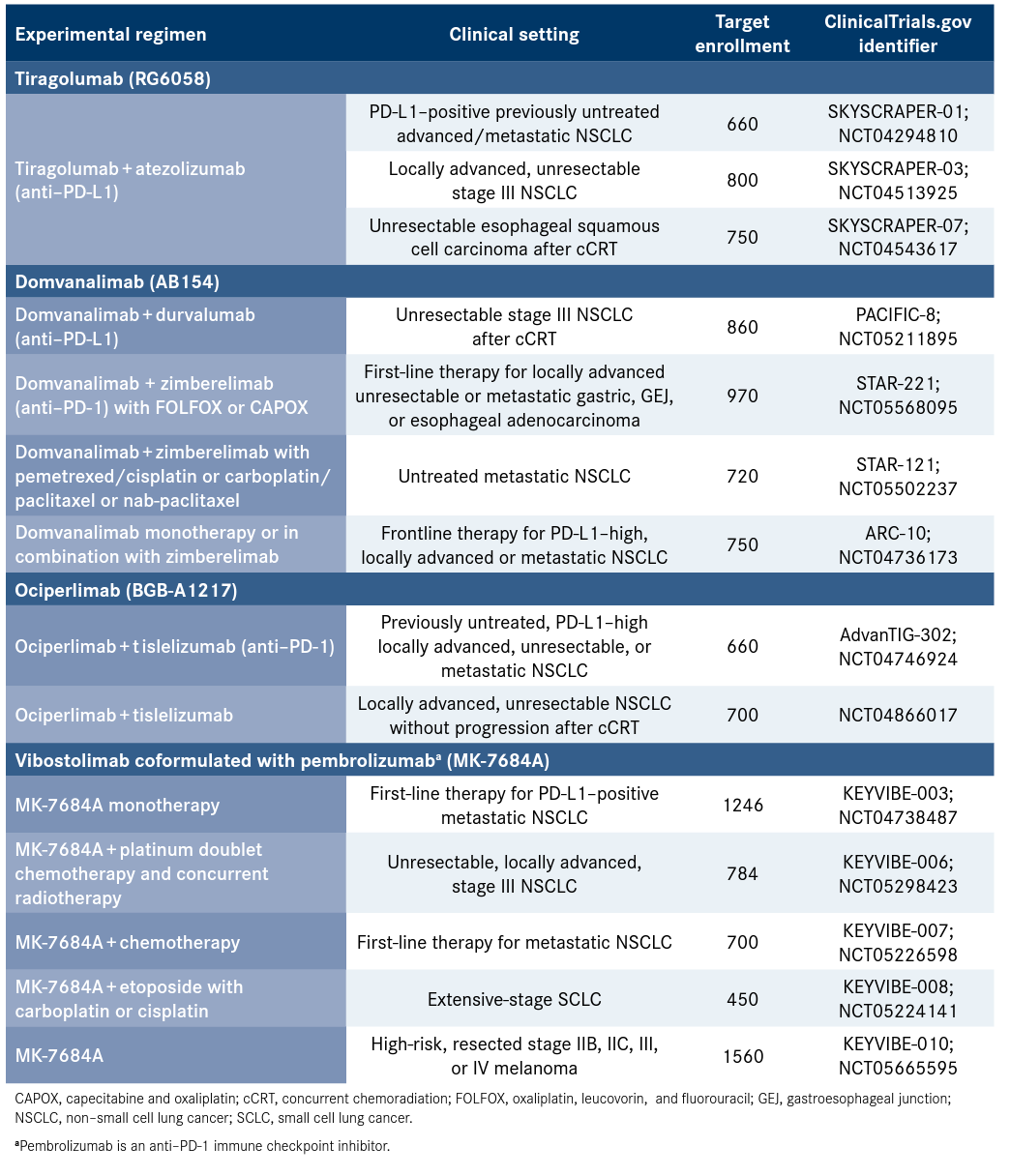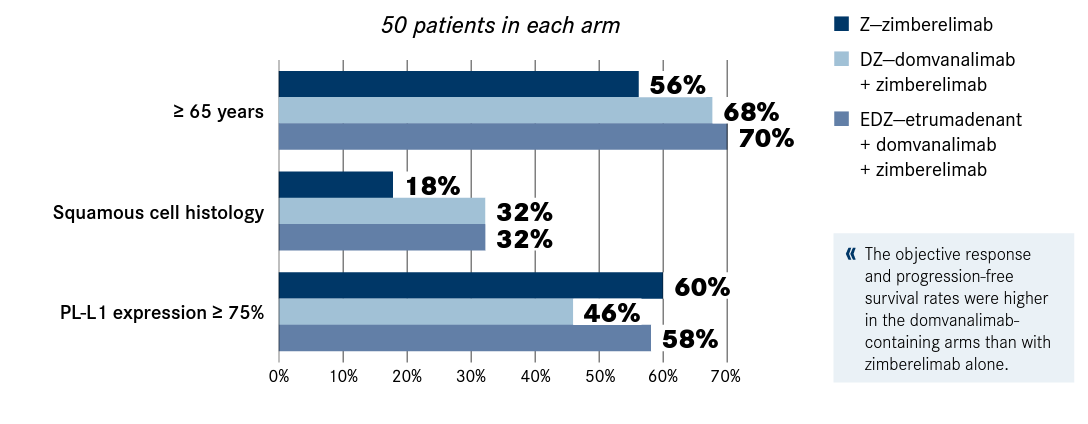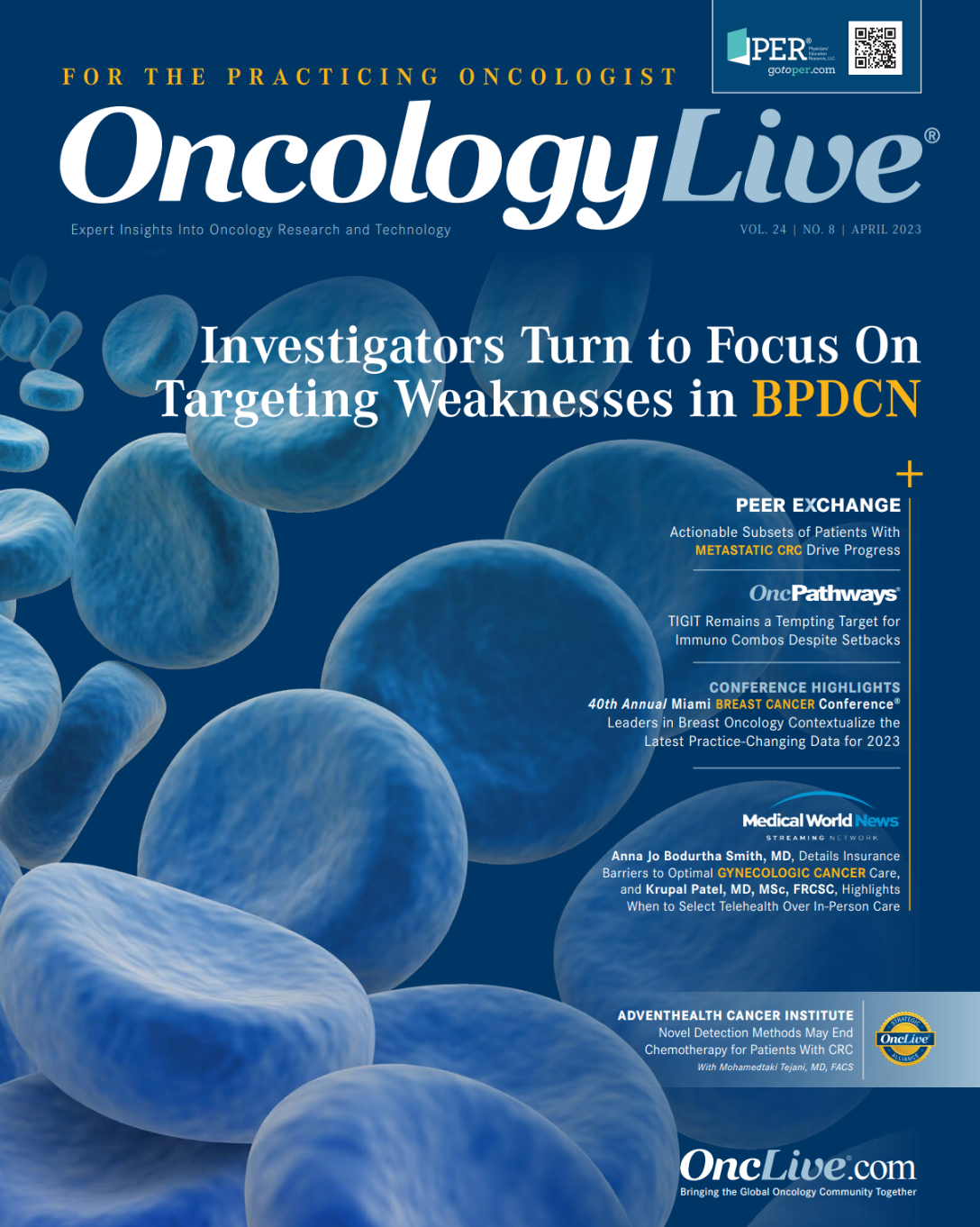Publication
Article
TIGIT Remains a Tempting Target for Immunotherapy Combinations, Despite Setbacks
Author(s):
Despite a high-profile clinical disappointment, the TIGIT immune checkpoint remains an important target for anticancer therapy, with research programs testing novel agents moving forward in non–small cell lung cancer and a range of other tumor types.
Jedd D. Wolchok, MD, PhD, FASCO

Despite a high-profile clinical disappointment, the TIGIT immune checkpoint remains an important target for anticancer therapy, with research programs testing novel agents moving forward in non–small cell lung cancer (NSCLC) and a range of other tumor types.
Investigators believe TIGIT plays a crucial role in inhibiting adaptive and innate immune responses against tumor cells, making it a promising anticancer target, particularly in combination with other immunotherapeutic strategies, such as immune checkpoint inhibitors (ICIs) directed at PD-1/PD-L1.1
The exploration of TIGIT is part of the next steps in cancer immunotherapy aimed at overcoming therapeutic resistance that can take hold because of numerous factors that modulate the immune response, according to Jedd D. Wolchok, MD, PhD, FASCO.
Wolchok is a medical oncologist and consultant at Memorial Sloan Kettering Cancer Center and the director of the Sandra and Edward Meyer Cancer Center at Weill Cornell Medicine, both in New York, New York, and the 2014 Giants of Cancer Care® award winner for melanoma. He was among several leading immuno-oncologists who discussed the potential for targeting TIGIT during an American Society of Clinical Oncology (ASCO) Plenary Series session in December 2022.2
During the past decade, findings from many clinical studies and analyses involving ICIs directed at PD-1/PD-L1 and CTLA-4 have led to the development of “a central dogma for cancer immunotherapy,” Wolchok said. This includes the realization that although some patients may achieve durable disease control with ICI therapy, numerous factors such as suppressive cells, a hostile microenvironment, and insufficient co-stimulation modulate responses.2
As investigators focus on mechanisms that may help tumor cells evade an immune response, TIGIT has emerged as a target of interest. More than 30 monoclonal antibodies (mAbs) directed at TIGIT are in development. Although most of these novel therapies are in preclinical or phase 1 stages, the pipeline includes several agents that have advanced to phase 3 testing (Table).2
Table. Select Phase 3 Clinical Trials of TIGIT-Targeting Antibodies2

TIGIT's Role in Immune System
TIGIT, which stands for T-cell immunoglobulin and ITIM domain, is among the coinhibitory receptors that help regulate T-cell responses, a family that includes PD-1, CTLA-4, and LAG-3. Investigators discovered TIGIT through bioinformatic analyses about 15 years ago, with different research groups variously identifying it as WUCAM, Vstm3, and Vsig9.3,4
As a surface protein, TIGIT is expressed on multiple immune cells, including memory T cells and natural killer (NK) cells.2,5 Findings from several studies have detected TIGIT overexpression in the microenvironment of numerous tumor types, including lung, kidney, liver, glioma, melanoma, colorectal, gastric, and neuroblastomas.6
In one pan-cancer analysis, investigators found that TIGIT expression was upregulated in most of 33 cancer types in a comparison of normal and tumor samples from 2 databases.
Moreover, high TIGIT expression was associated with a poor prognosis for overall survival (OS) in tumor samples from patients with renal cell and papillary cell carcinomas of the kidney, lower-grade gliomas of the brain, and uveal melanoma.7
Over the years, investigators’ views on TIGIT’s role in the immune system have evolved into an understanding that it is more complex than initially envisioned, according to Solange Peters, MD, PhD, the 2020-2022 president of the European Society for Medical Oncology (ESMO) and chair of medical oncology at Lausanne University in Switzerland.
TIGIT is among 4 regulatory receptors expressed on T cells or NK cells that are part of the CD226 pathway, Peters said during the ASCO Plenary Series session. CD226 is a co-stimulatory receptor that interacts primarily with CD155 but also with CD112 on the tumor cells to activate T cells and NK cells, thus generating an immune response that promotes cancer cell killing, Peters said. The receptors in the CD226 axis, as the pathway is known, that inhibit cancer cell killing are TIGIT, CD96, and PVRIG (Figure18).2,8
Figure 1. TIGIT in the Context of the CD226 Axis8

“It’s quite important to imagine that anti-TIGIT [therapy] is one of the ways to reactivate the interaction of CD226 with CD155,” Peters said. “The other important point to keep in mind [is that] it’s probable that TIGIT is also expressed on Tregs [regulatory T cells]. So, you have here a mechanism of ADCC—antibody-directed cell cycle cytotoxicity—which would potentially be related to an anti-TIGIT monoclonal antibody, resulting in a depletion of Treg cells.”
Of the inhibitory receptors in the CD226 axis, TIGIT is the most extensively studied, according to David Planchard, MD, PhD, who discussed the landscape during a symposium at the ESMO Immuno-Oncology Congress in December 2022. GSK, which is among the pharmaceutical companies developing TIGIT-targeting therapies, sponsored the program.9 Planchard is head of the thoracic pathology committee at the Institut Gustave Roussy in Villejuif, France.
TIGIT-targeting antibodies are being tested in nearly 20 tumor types. Studies involving patients with NSCLC represent the largest slice of the development pie. Testing also is under way in digestive tract, gynecologic, and genitourinary cancers as well as in B-cell hematologic malignancies and multiple myeloma.9
In NSCLC, there is a need for new strategies to improve responses to immunotherapy, Peters said. ICI therapy is established for the frontline treatment of most patients with advanced disease without EGFR or ALK alterations as monotherapy or in combination with chemotherapy, she noted. Patients with PD-L1 expression of 50% or greater are candidates for frontline PD-1/PD-L1–targeting monotherapy.2
However, at least 1 in 5 patients with high PD-L1 expression will have progressive disease as the best response to ICI monotherapy, and many patients whose disease stabilizes with ICI therapy will eventually experience progression, Peters said. “We have to face this unmet need of addressing immune checkpoint resistance, this acquired resistance, where initially you have a response and later, down the road, progression of the disease,” she said. “All of this represents potential opportunities for improvement of our treatment strategies.”2
Mixed Results for Novel Agents
Although TIGIT continues to attract interest in the drug development field, clinical findings for novel antibodies targeting the checkpoint have been mixed. AntiTIGIT monotherapy resulted in objective response rates (ORRs) ranging from 0% to 5% across several trials in advanced solid tumors, Planchard said. Treatmentrelated adverse events of any grade included rash, pruritus, infusion site reactions, and anemia.9
As combination therapy, tiragolumab (RG6058), the most advanced anti-TIGIT mAb in terms of development, initially demonstrated clinical benefit in the phase 2 CITYSCAPE trial (NCT03563716) but then faltered in phase 3 studies.
In CITYSCAPE, patients with chemotherapy- naïve recurrent or metastatic PD-L1–positive NSCLC were randomly assigned to receive atezolizumab (Tecentriq), a PD-L1–directed ICI, with tiragolumab or placebo. PD-L1 positivity was defined as a tumor proportion score of 1% or greater.10
In the primary analysis, the novel combination resulted in an ORR of 31.3% (95% CI, 19.5%-43.2%) in 21 of 67 patients compared with 16.2% (95% CI, 6.7%-25.7%) in 11 of 68 patients who received atezolizumab plus placebo. Median progression- free survival (PFS) was 5.4 months (95% CI, 4.2-not estimable) with tiragolumab plus atezolizumab compared with 3.6 months (95% CI, 2.7-4.4) with atezolizumab alone (HR, 0.57; 95% CI, 0.37-0.90; P = .015).10
However, prospects for tiragolumab dimmed after findings from 2 phase 3 trials failed to establish a benefit with the addition of the agent to standard therapies.
In March 2022, Genentech, a member of the Roche Group, announced that the combination of tiragolumab plus atezolizumab and chemotherapy did not reach its coprimary end points of PFS and OS in the phase 3 SKYSCRAPER-02 study (NCT04256421) as first-line therapy in patients with extensive-stage SCLC. Patients who had not received prior systemic treatment for extensive-stage disease were randomly assigned to receive tiragolumab or placebo in combination with atezolizumab, carboplatin, and etoposide.11,12
After a median follow-up of 14.3 months, median PFS in the primary analysis set was 5.4 months (95% CI, 4.7-5.5) in the tiragolumab cohort (n = 196) and 5.6 months (95% CI, 5.4-5.9) in the standard therapy group (n = 201). Interim median OS was 13.6 months with both regimens.12
In May 2022, Genentech disclosed that the addition of tiragolumab to atezolizumab failed to show an improvement in PFS over atezolizumab alone as first-line therapy for patients with PD-L1high locally advanced or metastatic NSCLC in the phase 3 SKYSCRAPER-01 study (NCT04294810). Data from the first analysis for the coprimary end point of OS were immature, the company said. Details of the findings were not disclosed.13
News of the SKYSCRAPER-01 results rattled confidence in the potential for developing therapies aimed at the TIGIT checkpoint, according to market analysts.14,15 Nevertheless, evaluation of tiragolumab is ongoing in SKYSCRAPER-01 and several other NSCLC settings as well as in studies involving patients with recurrent/metastatic PD-L1–positive squamous cell head and neck carcinoma, esophageal carcinoma, and cervical cancer.16
Combination Revives Hope
The outlook for TIGIT-targeting therapies brightened in December 2022 with the release of findings from the phase 2 ARC-7 trial (NCT04262856), in which the anti-TIGIT mAb domvanalimab was evaluated as part of doublet and triplet therapy compared with a PD-1directed ICI in NSCLC.
Patients with stage IV NSCLC who had not been treated for metastatic disease and had PD-L1 expression of 50% or greater were randomly assigned to 1 of 3 study arms: zimberelimab (Z), a PD-1 inhibitor approved in China for classical Hodgkin lymphoma; domvanalimab plus zimberelimab (DZ); or etrumadenant, a novel adenosine 2 receptor antagonist, plus domvanalimab and zimberelimab (EDZ). Crossover from arm Z to the EDZ regimen was permitted (Figure 2).17
Figure 2. Key Patient Characteristics in ARC-7 Trial Arms17

The rationale for adding etrumadenant to the mix stems from the immuno-suppressant role that adenosine plays. The molecule affects Tregs as well as T effector cells and dendritic cells and is a source of interest to investigators seeking additional mechanisms to overcome immune resistance in cancer therapy, Wolchok said.2
During the ASCO Plenary Series program, Melissa L. Johnson, MD, presented interim efficacy findings from ARC-7. Johnson is director of lung cancer research at Sarah Cannon Research Institute and is chair of the oncology department and a member of the medical executive committee at TriStar Centennial Medical Center, both in Nashville, Tennessee.
The findings involved 133 patients randomly assigned to an ARC-7 treatment arm at least 13 weeks prior to data cutoff in August 2022, enabling investigators to review at least 2 scans from baseline to assess responses.17
The use of domvanalimab improved ORRs and PFS compared with zimberelimab alone. The ORRs were 27% in the Z arm, 41% in the DZ group, and 40% in the EDZ cohort; all responses were partial. The 6-month PFS rates were 43%, 65%, and 63%, respectively, in the Z, DZ, and EDZ arms. The median PFS rate was 5.4 months in the Z arm, 12.0 months in the DZ group, and 10.9 months with EDZ therapy. Those values translated into HRs of 0.55 and 0.65 for doublet and triplet therapy compared with antiPD-1 monotherapy.17
In terms of safety, the most common treatment-emergent adverse events were fatigue, nausea, constipation, dyspnea, decreased appetite, and pneumonia. Events of grade 3 or greater severity were observed in 58% of participants in the Z arm, 47% in the DZ group, and 52% in the EDZ arm. This included grade 5 events related to study treatment involving 1 patient with interstitial lung disease in the Z arm, 1 participant with myocarditis in the DZ group, and 2 with congestive heart failure in the EDZ arm.
The results support continued development of domvanalimab in NSCLC, which is ongoing in 3 phase 3 studies: ARC-10 (NCT04736173), STAR-121 (NCT05502237), and PACIFIC-8 (NCT05211895), according to Johnson.
The findings also may help bolster confidence in targeting TIGIT as a therapeutic strategy. “There have been mixed signals from prior studies looking at TIGIT targeting. The promising results of the combination immunotherapy treatment in this study support further investigation, and if confirmed, could lead to a new standard of care for patients with advanced lung cancer,” Lauren A. Byers, MD, said in speaking as an ASCO expert in advance of the Plenary Series program.18 Byers is an assistant professor at The University of Texas MD Anderson Cancer Center in Houston.
Of note, domvanalimab is designed differently from other TIGIT-targeting mAbs, including tiragolumab, in that the Fc region of the antibody is silent, thus avoiding the depletion of TIGITbearing immune cells that may augment the immune response.10,17,18
Uneven Results for Late-Stage Candidates
Findings for several other TIGIT-targeting therapies tested in combination regimens have been a patchwork of positive and negative data.
Ociperlimab
Ociperlimab, an anti-TIGIT antibody with an active Fc domain, is paired with tislelizumab, an anti–PD-1 mAb approved in China in combination with chemotherapy for patients with NSCLC, in the ongoing phase 1b AdvanTIG-105 study (NCT04047862). The study has 10 cohorts, including separate groups for patients with previously untreated metastatic for squamous NSCLC (cohort 1) and nonsquamous NSCLC (cohort 2).
The ORR was 57.5% (95% CI, 40.9%-73.0%) among 40 patients with squamous NSCLC in cohort 1 and 54.8% (95% CI, 38.7%-70.2%) among 42 participants with nonsquamous disease in cohort 2, according to results reported during the ESMO Congress in September 2022. The median duration of response was not evaluable in both cohorts.19
The most common treatment-related adverse events of any grade were anemia, decreased neutrophil counts, and decreased white blood cell counts. Events of grade 3 or greater severity were observed in 48.8% of patients, including serious events in 16.7%.19
However, the combination of ociperlimab plus tislelizumab was not as effective in patients with locally advanced or metastatic NSCLC who had received prior treatment with an ICI. In cohort 5 of AdvanTIG-105, the ORR was 8.0% (95% CI, 1.0%26.0%), with only 2 partial responses recorded among 25 patients.20
Meanwhile, the ORR reached 65.0% (95% CI, 48.3%-79.4%) among 40 patients with extensive-stage SCLC not previously treated for metastatic disease who received ociperlimab plus tislelizumab and a chemotherapy doublet in cohort 4 of AdvanTIG-105. The median duration of response was 4.3 months (95% CI, 3.2-5.6).21
Several studies testing ociperlimab-containing regimens are continuing, including the phase 3 AdvanTIG-302 trial (NCT04746924) in patients with locally advanced, unresectable, or metastatic NSCLC with PD-L1 expression of 50% or greater, previously untreated in the metastatic setting.
Vibostolimab
Investigators also have taken the approach of combining vibostolimab, an anti-TIGIT mAb, with pembrolizumab (Keytruda), a PD-1–directed ICI, in the same therapy, in a coformulation designated MK-7684A.
When the 2 drugs were tested as separate agents, the combination of vibostolimab plus pembrolizumab demonstrated an ORR of 26%, including 1 complete response, among 39 patients with PD-1/PD-L-1–naïve NSCLC treated during a first-in-human phase 1 study (NCT02964013).22
However, the coformulation failed to improve PFS compared with docetaxel, a standard of care, in patients with previously treated metastatic NSCLC in an arm of the phase 2 KeyVibe-002 trial (NCT04725188), according to Merck, the company developing the therapy.23
The study, which is active but no longer recruiting participants, consists of an open-label arm in which MK-7684A was administered alone and 2 blinded arms in which participants received MK-7684A plus docetaxel or placebo plus docetaxel.23
Findings from the open-label arm showed that MK-7684A alone “did not reach statistical significance for the primary end point of PFS and was numerically less effective compared with docetaxel,” Merck said in a news release on March 16, 2023. Study investigators were advised to switch patients to standard care unless they are benefiting from therapy with MK-7684A alone.23
At the same time, Merck is continuing to test the efficacy of MK-7684A when added to docetaxel compared with docetaxel alone in KeyVibe-002. The company also is pursuing studies of the coformulation in clinical trials recruiting more than 4000 patients, including in several large phase 3 trials in NSCLC and melanoma.23
References
- Chauvin JM, Zarour HM. TIGIT in cancer immunotherapy. J Immuno ther Cancer. 2020;8(2):e000957. doi:10.1136/jitc-2020000957
- Garassino MC, Wolchok JD, Johnson ML, Peters S. ASCO Plenary Series: December 2022 Session; virtual. December 20, 2022. Accessed March 14, 2023. https://meetings.asco.org/asco-plenary-series/15346?presentation=217314#217314
- Anderson AC, Joller N, Kuchroo VK. Lag-3, Tim-3, and TIGIT co-inhibitory receptors with specialized functions in immune regulation. Immunity. 2016;44(5):989-1004. doi:10.1016/j. immuni.2016.05.001
- Florou V, Garrido-Laguna I. Clinical development of anti-TIGIT antibodies for immunotherapy of cancer. Curr Oncol Rep. 2022;24(9):1107-1112. doi:10.1007/s11912-022-01281-5
- Yu X, Harden K, Gonzalez LC, et al. The surface protein TIGIT suppresses T cell activation by promoting the generation of mature immunoregulatory dendritic cells. Nat Immunol. 2009;10(1):48-57. doi:10.1038/ni.1674
- Annese T, Tamma R, Ribatti D. Update in TIGIT immune-checkpoint role in cancer. Front Oncol. 2022;12:871085. doi:10.3389/ fonc.2022.871085
- Wen J, Mao X, Cheng Q, Liu Z, Liu F. A pan-cancer analysis revealing the role of TIGIT in tumor microenvironment. Sci Rep. 2021;11(1):22502. doi:10.1038/s41598-021-01933-9
- Conner M, Hance KW, Yadavilli S, Smothers J, Waight JD. Emergence of the CD226 axis in cancer immunotherapy. Front Immunol. 2022;13:914406. doi:10.3389/fimmu.2022.914406
- Planchard D. How is the CD226 Axis being studied in clinical trials? ? Presented at: ESMO Immuno-Oncology Congress 2022 Industry Satellite Symposium; December 9, 2022; virtual. Accessed March 16, 2023.
- Cho BC, Abreu DR, Hussein M, et al. Tiragolumab plus atezolizumab versus placebo plus atezolizumab as a first-line treatment for PD-L1-selected non-small-cell lung cancer (CITYSCAPE): primary and follow-up analyses of a randomised, double-blind, phase 2 study. Lancet Oncol. 2022;23(6):781-792. doi:10.1016/S14702045(22)00226-1
- Genentech provides update on phase III SKYSCRAPER-02 study in extensive-stage small cell lung cancer. News release. Genentech. March 29, 2022. Accessed March 19, 2023. https://www.gene.com/media/press-releases/14947/2022-03-29/genentech-provides-update-on-phase-iii-s
- Rudin CM, Liu SV, Lu S, et al. SKYSCRAPER-02: Primary results of a phase III, randomized, double-blind, placebo-controlled study of atezolizumab (atezo) + carboplatin + etoposide (CE) with or without tiragolumab (tira) in patients (pts) with untreated extensive-stage small cell lung cancer (ES-SCLC). J Clin Oncol. 2022;40(suppl 17):LBA8507. doi:10.1200/JCO.2022.40.17_suppl.LBA8507
- Genentech reports interim results for phase III SKYSCRAPER-01 study in PD-L1-high metastatic non-small cell lung cancer. News release. Genentech. May 10, 2022. Accessed March 19, 2023. https://www.gene.com/media/press-releases/14951/2022-05-10/genentech-reports-interim-results-for-ph
- Plieth J. Looking beyond Roche’s Tigit bombshell. Evaluate Vantage. May 11, 2022. Accessed March 19, 2023. https://www.evaluate.com/vantage/articles/news/trial-results/looking-beyond-roches-tigit-bombshell
- Waldron J. To TIGIT or not to TIGIT? Roche’s latest trial flop casts shadow on Big Pharma’s $6B bet. FIERCE Biotech. May 16, 2022. Accessed March 19, 2023. https://www.fiercebiotech.com/biotech/tigit-or-not-tigit-roches-latest-trial-flop-has-implications-big-pharmas-big-bet
- Product development portfolio. Roche. Updated February 2, 2023. Accessed March 19, 2023. https://www.roche.com/solutions/pipeline#81ad1b25-f415-4714-9450-45c188614658
- Johnson ML, Fox W, Lee YG, et al. ARC-7: Randomized phase 2 study of domvanalimab + zimberelimab ± etrumadenant versus zimberelimab in first-line, metastatic, PD-L1-high non-small cell lung cancer (NSCLC). J Clin Oncol. 2022;40(suppl 36):397600. doi:10.1200/JCO.2022.40.36_suppl.397600
- Combination therapy that includes a novel antibody is superior to immunotherapy alone for advanced non-small cell lung cancer. News release. American Society of Clinical Oncology. December 19, 2022. Accessed March 21, 2023. https://old-prod.asco.org/about-asco/press-center/news-releases/combination-therapy-includes-novel-antibody-superior?cid=DM12318&bid=228006457
- Yu Y, Huang D, Gao B, et al, 1017P — AdvanTIG-105: phase Ib dose-expansion study of ociperlimab (OCI) + tislelizumab (TIS) with chemotherapy (chemo) in patients (pts) with metastatic squamous (sq) and non-squamous (non-sq) non-small cell lung cancer (NSCLC). Ann Oncol. 2022; 33(suppl 7):S448-S554. doi:10.1016/annonc/ annonc1064
- Frentzas S, Meniawy T, Kao SCH, et al. 126P AdvanTIG-105: phase Ib dose-expansion study of ociperlimab (OCI) + tislelizumab (TIS) in patients (pts) with checkpoint inhibitor (CPI)-experienced advanced non-small cell lung cancer (NSCLC). Immunol Technol. 2022;16(suppl 1):100238. doi:10.1016/j.iotech.2022.100238
- Zhang J, Hussein M, Kao SCH, et al, 148P AdvanTIG 105: phase 1b dose expansion study of ociperlimab plus tislelizumab with chemotherapy in patients with extensive stage small cell lung cancer. Immunol Technol. 2022;16(suppl 1):100260. doi:10.1016/j. iotech.2022.100260
- Niu J, Maurice-Dror C, Lee DH, et al. First-in-human phase 1 study of the anti-TIGIT antibody vibostolimab as monotherapy or with pembrolizumab for advanced solid tumors, including non-smallcell lung cancer. Ann Oncol. 2022;33(2):169-180. doi:10.1016/j. annonc.2021.11.002
- Merck provides update from open-label arm of phase 2 KeyVibe-002 trial evaluating MK-7684A, a coformulation of vibostolimab and pembrolizumab, in previously treated patients with metastatic nonsmall cell lung cancer (NSCLC). News release. Merck. March 16, 2023. Accessed March 23, 2023. https://www.merck.com/news/merck-provides-update-from-open-label-arm-of-phase-2-keyvibe-002-trial-evaluating-mk-7684a-a-coformulation-of-vibostolimab-and-pembrolizumab-in-previously-treated-patients-with-metastatic-non-small/








